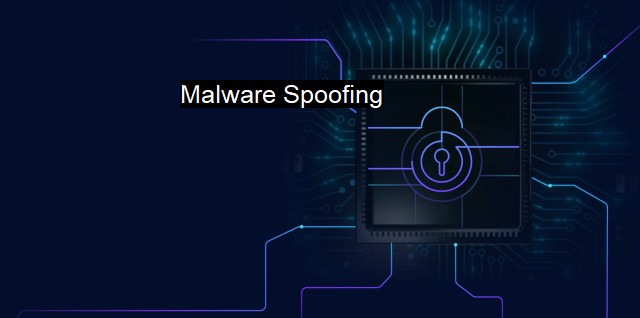What is Malware Spoofing?
The Threat of Malware Spoofing: Protecting Against the Latest Cybersecurity Challenge in the Digital World
Malware spoofing is an alarming trend in the world of cybersecurity that is increasingly becoming a major concern and challenge for individual users, IT professionals, and security experts around the world. malware spoofing involves the camouflaging of malicious software or scripts to appear as benign and trustworthy codes or functionality. By posing as familiar and safe, these camouflaged entities can trick both human users and automated systems into interacting with them, allowing them to infiltrate and compromise integral parts of a system's infrastructure.Understanding malware spoofing requires understanding the broader concept of spoofing in the field of cybersecurity. Spoofing, in general, refers to any situation where an entity tricks a system or a user into believing it is something else. It could, for instance, involve a phishing email pretending to be a reputable company to trick users into revealing their confidential information. Malware spoofing is a specific variant of this tactic where the entity pretending is a piece of malicious software or a malicious code.
There are several ways malware can present itself as harmless or even potentially helpful. One common tactic is for malware to mimic reputable, well-known software. For instance, malware can pretend to be a standard software update, a recognized anti-virus program, or any form of widely trusted digital content. By presenting itself as such, the malware seeks to lower the guard of the potential victims, hiding its malevolent intent under the guise of routine and reliable system activity.
A more sophisticated form of malware spoofing is when the malware infiltrates the servers or communications of trusted entities, such as service providers or organizations. From this vantage point, the malware isn't just disguised as trustworthy material; it can deliver itself under the 'official' banner of these reputable entities, greatly enhancing its credibility. Through this strategy, malware can successfully bypass many security layers, even having the potential to avoid detection from less sophisticated antivirus programs.
Another approach of malware spoofing involves exploiting the root certificate of a device. The root certificate is the top-most authority in a certificate chain that the operating system trusts. If a malware manages to spoof this root certificate, it would gain remarkable authority and freedom, essentially acting on behalf of the operating system. Such powerful malware can harm a system extensively by introducing potentially devastating changes and actions.
The main objective of malware spoofing is to infiltrate the target system's defences undetected, allowing bad actors to steal sensitive data, disrupt functionality or manipulate systems for their benefit. The scopes of such attacks can massively vary, from demanding ransom in exchange for stolen data, manipulating trading systems for monetary gains, political or industrial espionage, or even crippling national or international infrastructures as part of cyber warfare activities.
When considering defence strategies against malware spoofing, state-of-the-art antivirus software is crucial. its effectiveness heavily relies on the potency of its system registry integrity monitoring techniques, heuristic codes analysis, and continuous updates about latest malware-counterfeiting strategies. Companies should also consider adopting proactive monitoring and technical defence measures such as intrusion detection systems, two-factor authentication, firewalls, encryption, and sandboxes. Comprehensive security awareness training should be provided to all employees to better equip them in various cyber threats recognition, including recognizing disguised malware and understanding the best practices in dealing with suspected malicious content.
It is wise to engage with a cybersecurity consultation firm for a systematic vulnerability assessment, risk mitigation advice, and incident response planning, aligning even better with the overall security policy of the organization.
Malware spoofing is a serious, evolving concern for organizations and individuals alike. with robust security measures, proper awareness, and the right technical tools, its damaging effects can be minimized if not completely avoided. Understanding the behaviour, tactics, and threats posed by a spoofed malware can go a long way in not just defending against them, but in contributing towards a more secure digital world.

Malware Spoofing FAQs
What is malware spoofing?
Malware spoofing is a technique used by cybercriminals to disguise malicious software as legitimate programs or files.How does malware spoofing work?
Malware spoofing works by using a combination of techniques such as disguising file extensions, mimicking the user interface of legitimate programs, and hiding executable code within innocent-looking files.How can I protect myself from malware spoofing?
To protect yourself from malware spoofing, it's important to keep your antivirus software up to date, avoid downloading software from unverified sources and be cautious of any suspicious-looking files or programs. Additionally, practice safe online behavior such as not clicking on links or attachments from unknown sources.What are the potential consequences of malware spoofing?
The consequences of malware spoofing can be severe, ranging from data theft, financial losses and damage to your computer system. In some cases, malware spoofing can even lead to the complete compromise of your computer or network.| | A | | | B | | | C | | | D | | | E | | | F | | | G | | | H | | | I | | | J | | | K | | | L | | | M | |
| | N | | | O | | | P | | | Q | | | R | | | S | | | T | | | U | | | V | | | W | | | X | | | Y | | | Z | |
| | 1 | | | 2 | | | 3 | | | 4 | | | 7 | | | 8 | | |||||||